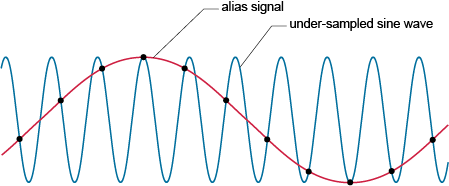3.2 Sampling and quantisation
Sampling is the process of converting a continuous analogue time signal into a discrete time representation. It is one of the first stages in converting an analogue signal (of which sound is a prime example) to a digital equivalent.
Figure 3.1 shows an analogue signal sampled at regular intervals of Ts. During sampling, the value of the source signal is measured. In principle each sample can perfectly represent the value of the waveform at that instant.

To represent the analogue signal satisfactorily, certain sampling criteria must be met. One relates to the rate of sampling. This is governed by the sampling theorem, which defines the unique relationship between the source signal’s bandwidth fb and the sampling frequency , where Ts is the sampling period. There is no loss of information between the original and sampled signals if and only if the signal is sampled at a rate that is at least twice fb:
So, for example, a signal with a bandwidth of 4 kHz must be sampled at least 8000 times per second to preserve all the signal’s information. As sampling rates are commonly given in kHz or MHz, the minimum sampling rate here would be given as 8 kHz.
If the sampling theorem is not upheld, aliasing occurs. A frequently encountered visual example of aliasing is the apparent backward rotation of spoked wheels in films showing vehicles travelling forwards. Audio aliasing, in which a spurious signal is represented by the samples (Figure 3.2), can be heard in the following activity.
Activity 3.1 Exploratory
In this audio track you hear audio aliasing. A short piece of speech (‘In my garden I have an apple tree, a hazel tree and a pine tree’) is heard six times. On each repetition the sampling rate is half the rate of the one before. As the sampling rate reduces, aliasing becomes more prominent. The six sampling rates are: 44.1 kHz, 22.05 kHz, 11.025 kHz, 5.512 kHz, 2.756 kH and 1.378 kHz.

